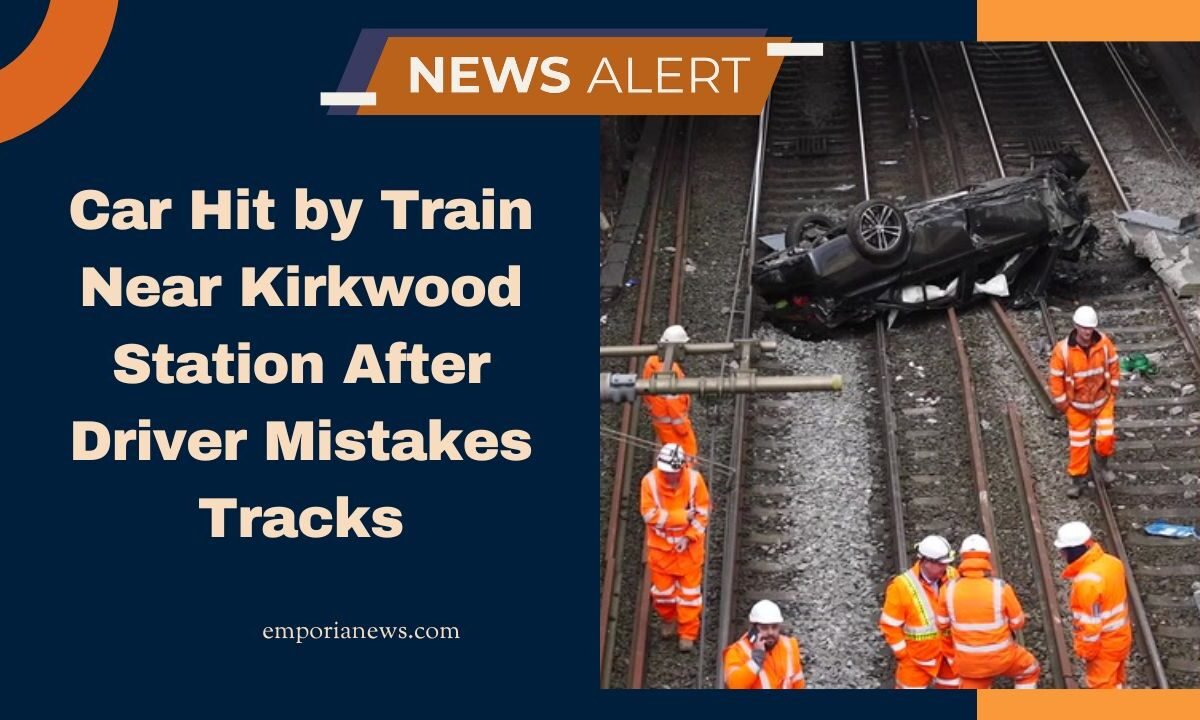A startling incident unfolded near Kirkwood Train Station, Missouri, when an elderly driver, apparently disoriented by nearby construction, drove onto the railroad tracks thinking it was a road. Before authorities or railroad personnel could intervene, a cargo train collided with the vehicle. Miraculously, the driver escaped with no reported injuries.
Incident Details: What Happened
- The collision occurred adjacent to the Kirkwood Train Station, where ongoing construction had altered the traffic layout.
- The elderly driver, confused by changes in road alignment, drove into the tracks.
- As police were contacting railroad officials, a cargo freight train struck the car.
- The driver safely exited before the impact; there were no injuries reported.
- Witnesses in the area initially heard the crash and rushed to check, relieved that the driver was okay.
- The incident reignites questions about construction signage, safety at rail crossings, and public awareness.
Timeline & Key Facts
| Time / Phase | Action / Observation | Significance |
|---|---|---|
| Pre-incident | Construction altering road access near station | Changed sightlines may create confusion |
| Driver’s action | Drove vehicle onto tracks | Mistook tracks for a roadway |
| Police notification stage | Authorities were calling railroad officials | Collision occurred before full clearance |
| Collision | Freight train struck vehicle | Impact occurred despite warnings |
| Outcome | Driver escaped unharmed | Best possible outcome under dangerous circumstances |
Why This Incident Raises Alarm
1. Construction-induced confusion
Altered lanes, barricades, and temporary detours can disrupt normal traffic expectations. In this case, the driver may have assumed the tracks were a continuation of a road.
2. Limited reaction time
By the time authorities were alerted, the train impact was imminent. Rail speeds and minimal clearance make prevention crucial.
3. Risks at railroad crossings
Each crossing is marked with crossing identification signs (small blue or white signs) containing a unique number. If a vehicle becomes stuck, calling that number helps railroad companies locate the exact crossing—to stop train traffic. These systems exist, but rely on public awareness.
4. Vulnerability of road users
Elderly or unfamiliar drivers are more susceptible to confusion when road patterns change. The absence of clear, intuitive signage compounds the risk.
Rail Crossing Safety Measures & Best Practices
- Prominent signage: Crossing IDs and emergency contact information must be clearly visible even during construction.
- Advance warnings: Flashing lights, barriers, or flags ahead of altered crossings alert drivers early.
- Road reconfiguration clarity: Temporary road markings, arrows, and barriers should intuitively channel vehicles away from tracks.
- Public awareness campaigns: Drivers need reminders that rail crossings are not roadways—even where construction makes lines ambiguous.
- Rapid emergency response protocols: Once a vehicle is on a track, quick coordination between police, railroad dispatchers, and train operators is essential.
Implications & Lessons Learned
- Urban or suburban areas with active rail lines and ongoing construction create a hazardous blend of changing traffic patterns and fixed infrastructure.
- Even a momentary misjudgment can lead to life-threatening collisions—fortunately mitigated here by the driver’s timely escape.
- Infrastructure planners and contractors must prioritize intuitive traffic flow, especially around crossings.
- Public education about rail crossing safety, especially in transition zones (construction, detours), is crucial.
The train collision near Kirkwood Station, though fortunately injury-free, is a wake-up call. It underscores how construction zones around rail crossings amplify risks, especially for vulnerable or confused drivers.
Effective signage, clear road layouts, and public awareness are vital to prevent future incidents. As railway and municipal authorities assess this near miss, their response must emphasize safety clarity at every crossing.



